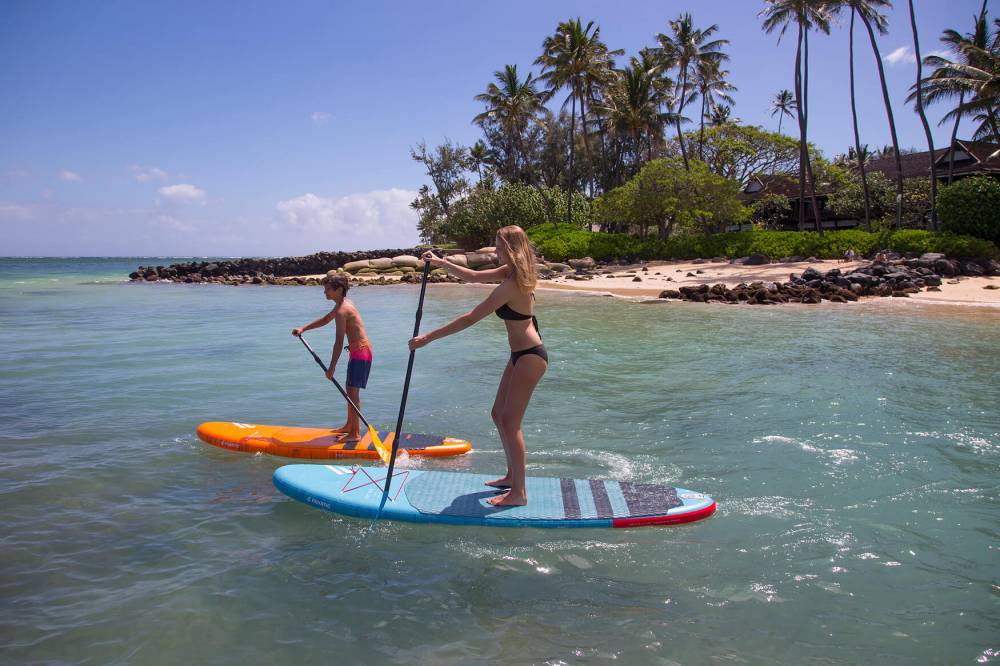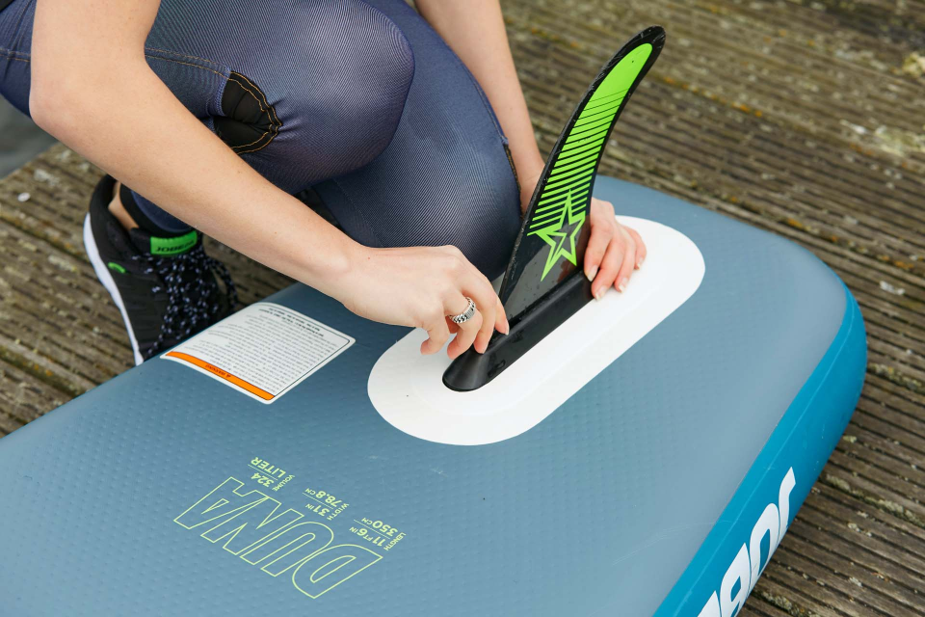A Stand Up Paddle can be a way to enjoy the water, explore nature from a new perspective, keep fit and have endless fun alone, with friends and with the whole family. If it is true that Sup is an activity that can be practiced all year round, it is also true that summer and summer are the best time to fully enjoy a paddle board. Think of the beauty of getting away from crowded beaches to explore small coves and inlets, enjoy a sunset over the sea, or explore mountain lakes and incredible waterways. A paddleboard can open up a new world of natural landscapes that can be experienced from a completely different point of view. Standing while you row, you can see things that are difficult to appreciate otherwise.
However, given the numerous possibilities offered by a paddleboard and the ease of use, it must be said that the obstacle of the size of a SUP is often insurmountable for many. A rigid sup is not a really comfortable object to handle and transport, not to mention storage. Those who live in the city or even just half an hour from the sea or lake, very often give up due to lack of space in the house and the difficulty of transporting it by car.
Fortunately, to overcome these problems there are the Inflatable Sup that can be conveniently stored in a medium-sized backpack and therefore are incredibly comfortable and easy to carry. But are they also okay?
The doubt of many is that an inflatable SUP is just a toy for children or little more. The one regarding inflatables is a fairly widespread prejudice, due in part to the presence on the market of products that are too cheap and underperforming, and to the fact that until a few years ago the inflatables were not what they are today. Yes, because today there are high quality inflatable SUPs that are able to not make you regret a rigid Sup, especially in certain conditions. Not to mention the fact that in terms of some features, first of all stability, inflatable SUPs are even better than rigid SUPs!
At this point there remains the question of how to choose an inflatable Sup and what are the characteristics that should be taken into consideration before purchasing.
Inflatable Sup technology and materials
Not all inflatable Sups are made the same way. There are big differences in the materials and construction methods used in inflatable paddle boards. Without going too far into the different materials and technologies used, it is at least important to know that there are two main construction types: single layer and double layer.
Single Layer boards are made with a single layer of material. These inflatable paddle boards will tend to be light and cheap, but also less rigid. To compensate for the lower stiffness of using a single panel, they are often thicker.
Double Layer boards have a stronger construction but also heavier and more expensive. These boards have a second layer of reinforced PVC fabric bonded to the main layer. Double Layer boards are less common due to both the higher cost and the general tendency to seek lightness. However, the extra layer gives the board greater stiffness, strength and durability.
Finally, there is a third type of Stand Up Paddle with a structure called " fusion ". These are Single Layer Paddle Boards which have additional reinforcement in the material. Sort of a compromise to keep both weight and cost down, but still get good durability and stiffness for most conditions.
In principle, a single layer board is more than enough for a first Sup. Double layer boards are recommended for those looking for better performance, especially in waves, in particular conditions (wind, chop ...) or in the case of very, very heavy riders.
Types of Stand Up Paddle
Inflatable sup, like rigid sup, are not all the same. There are models that favor stability, others manageability, some are more suitable for use at sea, others in rivers. To choose a board that suits your needs, the important thing is, as always, to understand what we are looking for in a paddle board and how we imagine to use it.
Allround SUP I'm sup with a rounded nose and nice wide. The length varies between 9 and 10.8 feet and the width between 32 and 34 inches. They are boards optimized to offer the right compromise between handling and stability. They are the most versatile models, designed to work in most conditions, obviously without excelling in any. Generally they are the best choice as a first sup, when the goal is simply to take a board and paddle ... then the rest will come by itself!
Touring SUPs are supers with a slightly more elongated shape, with a pointed nose and adapted to paddling over long distances when an efficient glide is more important than handling. The length is generally between 11.6 and 12.6, while the width is 31 or 32 inches. They can be good as a first Paddle as long as you choose a model that is still large enough, if you plan to use it for hiking, exploring the coast and hours and hours of paddling don't scare you!
Racing SUP are racing boards, up to 14 feet or more long and less than 30 inches wide, with pointed nose and tail. Designed for maximum speed. They are not suitable as a first Stand Up Paddle
Surf SUP Yes, even with an inflatable Sup you can surf. Maybe without going to the extreme, but today technology allows to obtain inflatable SUPs that are sufficiently rigid and performing to have fun even on the waves. These are paddle boards quite similar to the Allround boards, with a rounded and wide nose, but a little shorter (even less than 9 feet) and manageable. They should also have more rigidity. On the other hand, a smaller board and therefore with less volume at the beginning can be a bit too unstable, moreover the paddling is less effective.
Whitewater SUP are boards suitable for use on rivers and can also deal with some rapid or river waves.
Yoga SUPs are wide and stable SUPs like the allround SUPs and with a long and soft pad deck.
Fishing SUP Fishing paddles are as wide and stable as allround sup and can have a variety of accessories to hold fishing rods and other gear.
Not to mention the SUP Windsurf and Sup foiling models
As a first SUP we highly recommend choosing an Allround or Touring model. The Allround models are however also suitable for Touring, Surfing, Yoga. The difference is that with a multipurpose model it will be possible to try the various disciplines more easily.
Choose the size of the Inflatable Sup

After choosing a paddle board category, you will still need to decide which board is best for you and your needs. This is where factors such as your weight, your level of training and your preferences come into play.
In principle, larger and heavier paddlers should paddle larger boards. The reference value to keep in mind is that of the liters of the table.
VOLUME SUP = YOUR WEIGHT x 2 or more (if you are a beginner) So at least 140 liters if you are 70kg.
The multiplier can go below 2 (even reaching a little more than one) in the case of very experienced paddlers and for use in specific disciplines.
In the case of inflatable SUPs, we generally have to deal with much larger volumes, even with the same length and width with a rigid board.
But besides the liters, there are many other nuances to consider regarding the shape and size of the board. Here are some general principles to get you started on understanding how a board's size and shape affect its performance:
A longer board will have more glide than a shorter one.
A narrower board will be faster than a wider board, but also less stable.
A wider board will be more stable than a narrower board.
Boards with a wider tail will be more stable than boards with a narrow tail.
Boards with a narrow tail will spin faster when surfing
In any case, to buy your board it is important to refer to the specifications of the model you have chosen, where the recommended size is usually indicated based on the weight of the rider.
Just to give a couple of examples, here are fairly common measurements for inflatable Sup:
Allround 10.4 / 10.6 X 33 X 5.5 (for riders up to 95-100 kg)
Touring 12.6 X 32 X 6 (for riders up to 100-110 kg)
The Fins system

Often underestimated, the fin system is a key element to be carefully evaluated.
In particular, the first difference is between integrated or removable fins. It goes without saying that the removable fins offer more possibilities as you can always replace them with a stiffer model or larger or smaller if you feel the need.
The second question concerns the number of fins. Very often there is only one box, for a fairly large central fin. Some models have 3 fins with two side fins that offer greater stabilization. Models with 2 or 4 fins are rarer.
Conclusions: which inflatable sup to choose

After having seen what are the aspects to consider when choosing an inflatable sup, here is our advice.
As your first inflatable SUP choose an Allround single layer SUP. Being single layer, we advise you not to save excessively on the price and maybe avoid super low cost products, but you don't even need to spend 1000 €. There are excellent packages of very valid inflatable Sup that include in addition to the board also a paddle, pump, bag that cost around € 500 (a little more or a little less).
Take a look at the inflatable sup for sale online on our shop and chat with us if you need advice!
We recommend looking for something more performing for those who think of using it to catch some waves, and then stiffness becomes an important factor, or to use it at sea even with a little wind and chop.
Pubblicato il 14 febbraio 2022 | Blog: SUP

